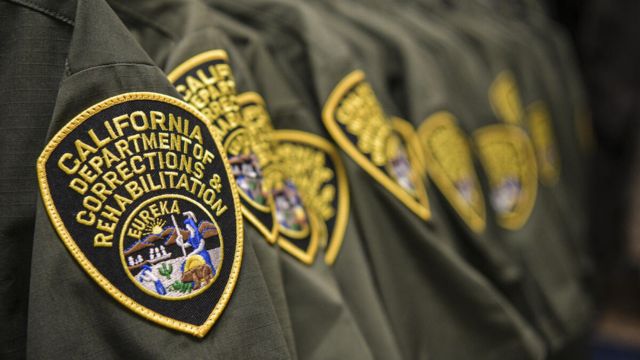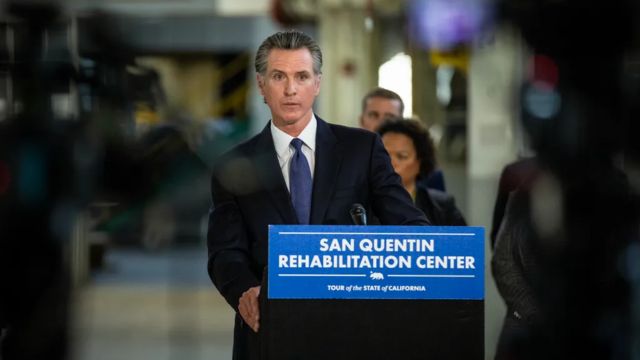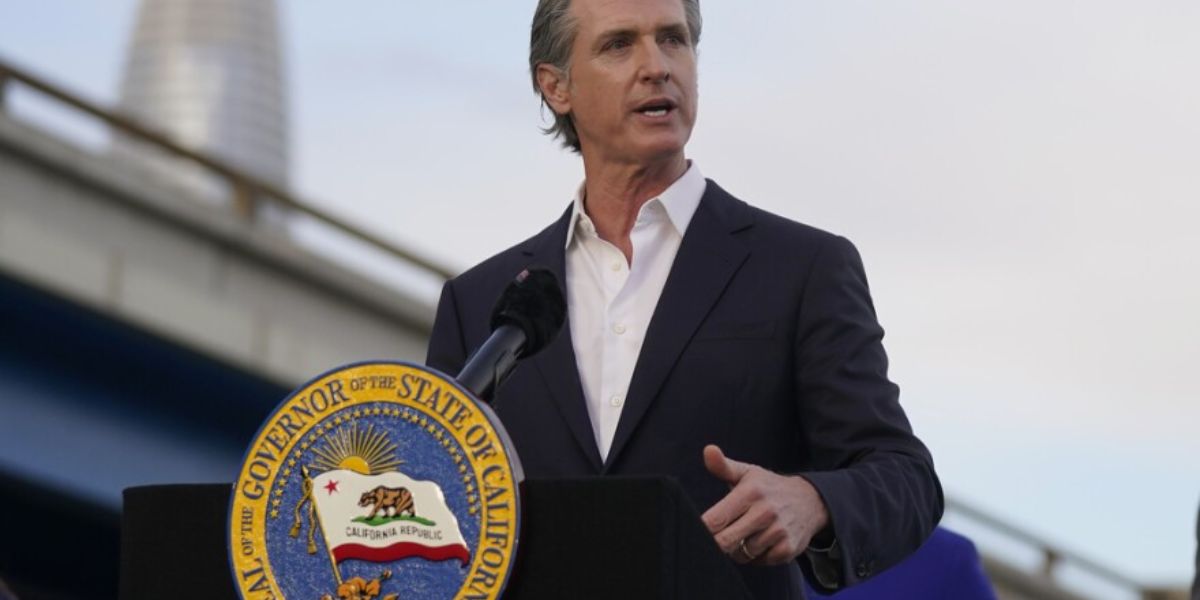WFCN –
The president of one of the biggest and most influential unions in California declared in a newsletter one year after assuming the position that he aspired to be “the 800 pound gorilla” in Sacramento politics.
Since then, in a manner it had never done before, the 26,000 state prison guards represented by the union known as the California Correctional Peace Officers Association, or CCPOA, has spent copiously. The largest beneficiary is Governor Gavin Newsom, who has accepted $2.9 million from the union since taking office.
That represents 31% of the union’s total political expenditures since 2001.
Under President Glen Stailey, the union contributed $1.75 million, the largest amount ever, to Newsom’s anti-recall campaign in 2021. Additionally, the union contributed $1 million to Proposition 1, Newsom’s treatment and housing plan for individuals suffering from severe mental illness, which was narrowly approved this year.
This stands in stark contrast to the union’s relationship with the three governors who came before Newsom, particularly with former Governor Arnold Schwarzenegger, who opposed the union’s proposed hikes and was the object of the union’s unsuccessful recall effort.
Over the past 20 years, CCPOA has given political campaigns contributions totaling more than $9.3 million.
The prison union’s largest political outlay before the Newsom administration was in 2005 when it allied with other labor unions to oppose a set of ballot propositions backed by Schwarzenegger that would have reduced state expenditures and undermined public employee unions. The unions prevailed, handily defeating Schwarzenegger.

According to campaign spending records, the union mostly avoided becoming involved in political disputes when former governor Jerry Brown was in office. It steered clear of the ballot proposals that voters approved and which reduced the number of people incarcerated in state prisons by granting parole privileges to prisoners and reducing the severity of punishments for nonviolent offenses.
SEE MORE –
NYPD Reports Recently Say! Antisemitic Incidents Make Up Over Half of Last Month’s Hate Crimes
The union’s coffers opened wide after Newsom assumed office.
According to conversations with lawmakers, labor leaders, former prison officials, and budget watchdogs, there are two ways to look at that cost.
In the first, it’s an overt show of dominance as one of the wealthiest unions in a state that supports labor reminds its leading lawmakers that they have the option to work with or against them on spending. That’s the main perspective as seen from outside the Capitol.
The union’s concern over its diminishing power is reflected in the other viewpoint, which is seen from within the Capitol. It is highly likely that California will have fewer prisons in the future, and fewer union-represented prison guards to staff them. The data is unambiguous: compared to 2011, California is now houseing 70,000 fewer prisoners in its state prison system.
Newsom proposed closing a single state prison at the beginning of his first term. Since then, he has closed three of them and canceled a contract on a fourth, saving hundreds of millions of dollars in total. However, given the budget deficit and the expectation that 4,000 fewer prisoners will be housed by the time he finishes his term in 2026, Newsom refrained this year from closing down another facility.
Newsom has been obstinate about keeping jails open in a year of tight budgets, even though it costs roughly $132,000 per year to house an inmate and the Legislative Analyst’s Office has stated that the state has enough space to close five additional prisons. He has stated that he wants to expand rehabilitation programs that can aid offenders in reintegrating into society and that he wants to maintain some extra capacity in the system.
In a written response, Izzy Gardon, a representative for Newsom, stated that the governor has attempted to strike a balance between the necessity for prison public safety and possible budget savings.
“Governor Newsom has closed more prisons than any of his predecessors, saving taxpayers billions of dollars without compromising public safety,” he said. “Meeting the changing requirements of our criminal justice system in a way that optimizes public safety and the prudent use of taxpayer funds has been the exclusive basis for the governor’s decisions.

CalMatters received written comments from union adviser and longtime Newsom ally Nathan Ballard, stating that the union and the governor had “respectful and substantive” discussions over possible jail closures this budget year.
Ballard stated that “union leaders aired their views and listened very carefully to the administration’s priorities.” “The governor expressed his appreciation for the union’s input. In the end, Gov. Newsom uses his own procedure, and speculating on how he comes to a specific conclusion would be reckless.
He said that the union’s priorities were reflected in the millions of dollars it poured into Newsom’s most important projects.
SEE MORE –
Half-Decade-Crime Now! Community Gathers to Commemorate 7 Years Since Det. Miosotis Familia Was Shot
“The CCPOA does not hesitate to fight hard for the governor’s initiatives when the union and the governor are in alignment policy-wise, as they were during Proposition 1,” he stated.
“A strong commitment to finding areas of agreement and progress is evident even as they grapple with policy areas where they are less aligned.”
Large contracts for CCPOA in the Newsom years
It is maybe not surprising that large sums of money are being spent in support of the state’s most powerful leader. What then happens to politicians who oppose the union representing prison guards?
The union spent almost $1 million to unseat Republican state senator John Moorlach in his Orange County election because he was raising concerns about pension benefits for state employees in California. Then the union-sponsored flyers began to appear, linking the senator, a Never Trump supporter, to the president’s ideas and preferences.
Lance Christensen, who managed Moorloch’s 2020 campaign, called it “cartoonish.” “You would think that a man like John Moorlach, who was law and order and generally supportive of public safety programs, would be desired by the public safety unions, whose duty it is to serve, defend, and protect Californians.”
In 2020, former senator John Moorlach’s bid for reelection was unsuccessful. He was the target of significant spending by the California Correctional Peace Officers Association, or CCPOA. Legislation introduced by the Republican legislator would have given public employees the option to select 401(k) plans over pensions. (Anne Wernikoff)
In 32 state legislative contests this century, the prison guard union has spent $3.8 million; $1.2 million of that total was used to unseat Moorlach. Democrat Dave Min defeated him 51%–49%.
Christensen stated, “They determined that it was time to pursue him head-on and remove him.”
The union, which represents roughly 10% of state employees, has surely achieved favorable agreements for its members; maybe none more so than in the previous year, when it succeeded in securing a $1 billion increase spread over three years. In addition to their pensions from the California Public Employees’ Retirement System, correctional officers also received a new retirement benefit financed by the state as part of the agreement. Furthermore, prison guards were allowed to forego the COVID-19 immunizations that the state required of other state employees.
The Legislative Analyst’s Office, which conducted an exceptionally rigorous review of planned prison guard raises in 2019 and 2021 and concluded that the Newsom administration provided “no evidence to justify (a) pay increase,” has persistently criticized such spending.
According to the report, there is no issue with recruitment or retention among California prison guards, and their pay are already competitive with those in the counties where they work, if not somewhat higher than those of similar job classifications.
The Legislative Analyst’s Office chastised the Newsom administration last year for continuously declining to release a 2018 compensation assessment that examined the pay and perks of prison guards. The administration releases pay studies pertaining to its other eighteen negotiating units on a regular basis.
Alternatively, the administration produced a 2022 compensation study, which was deemed “flawed” by the Legislative Analyst’s Office because to its omission of overtime pay and use of large, metropolitan counties as pay comparison points as opposed to the rural areas where the majority of prison guards are employed.
Legislative Analyst’s Office: “We recommend policymakers not use the study to assess whether the state’s compensation package for correctional officers is appropriate to attract and retain qualified workers because it is flawed to the point that it is not helpful in meeting its stated objective.”
The state’s budget crisis is now more acutely apparent, according to Brian Kaneda, deputy director of Californians United for a Responsible Budget.
Kaneda declared, “The CCPOA has a stranglehold on Sacramento politics.” “While everyone is having difficulty right now, prison guards are receiving a $1 billion pay increase. Explain how, in the midst of our historic budget imbalance, this would be the best course of action for California.
In response to a question about the union’s influence in Sacramento and the varying opinions regarding its authority, Ballard stated that the union’s leadership prioritizes its members over its lobby.
He declared, “Matters of character, not reputation, are the union’s leaders’ main concerns.” “The leaders of the CCPOA are street-smart correctional officers with decades of experience working in extremely difficult conditions; collectively, they are not overly preoccupied with perceived status.”
Is the closure of Newsom’s prisons influenced by CCPOA?
In 2020, Newsom started designating which prisons to close. In 2022, more happened. Then, despite the fact that thousands of jail beds remain unoccupied, Newsom ceased designating new facilities for closure.
What altered? One effect of the epidemic was an increase in the public’s perception of criminality, even as the majority of crimes that would normally result in jail time decreased.
That’s significant for a governor who might have goals outside Sacramento, according to a Democratic lawmaker who wished to remain anonymous for fear of reprisals from the governor’s office and the prison guard union.
The lawmaker stated, “I don’t think the CCPOA is the reason we’ve stalled on prison closures.” “I believe that the California Department of Corrections and Rehabilitation is being protected by the governor or a representative from the governor’s office.”
“I assume that the governor is softening his stance on public safety in light of his desire to advance nationally. He so takes great care to avoid giving the impression that he is lenient toward crime.
Speaking at San Quentin State Prison, Governor Gavin Newsom announces that on March 17, 2023, the facility will undergo a transformation with an emphasis on training and rehabilitation. (Do Nascimento Martin))
According to former Corrections Secretary Matt Cate, the prison guard union would never have had to account for such calculations during its peak during the boom of prison construction in the 1990s and 2000s. Both sides had an incentive to patch things up with the union back then.
After serving as Brown’s secretary of prisons for two years after Schwarzenegger’s 2008 appointment, Cate remarked, “At the time, the Democrats were more moderate than they are now and they were doing everything to support labor generally.” She left the position in 2011. Meanwhile, Republicans did not believe in rehabilitation or re-entry and were steadfast supporters of law enforcement and lengthy punishments.
CCPOA therefore had a clear field. Simply put, it was a lot easier work than what the CCPOA does now. Being an 800-pound gorilla is more difficult now than it was twenty years ago.
Cate questions if the union was the only, or even the primary, factor in Newsom’s decision to cease closing prisons. According to Cate, closing a jail is akin to shutting down “a small city,” with 3,000 prisoners and 800-1,000 staff members who are covered by twelve or more different unions. A federal monitor is in charge of the prison system’s medical treatment, while another federal monitor is in charge of the state’s prison mental health services.
Taking on and failing a Democrat
Assemblymember Reggie Jones-Sawyer, a Democrat from Los Angeles, was one lawmaker who defied the prison union and managed to keep his career alive. He claimed that the union’s acerbic strategies during the tenure of its president, Stailey, were reminiscent of the union’s strategies during the 1990s, when the organization’s influence peaked.
He claimed that “people got a cold if they sneezed.”
SEE MORE –
Silent-Crime! Fundraiser Organized by New Orleans Tour Company for Woman Killed in French Quarter
Jones-Sawyer was figuratively put in their crosshairs in 2020.
An internet advertisement featuring Stailey pointing at a wall of legislator images was released by the union in opposition to Jones-Sawyer. There was a piece of white paper with red dots and crosshairs over the picture of Jones-Sawyer. Jones-Sawyer saw that as a threat, and the union promised to remove and amend the advertisement.
Re-elected that year, Jones-Sawyer stated, “It became clear that if they wanted to get back the power, they needed to take somebody out to put the fear into everybody.” They believed that I was a simple mark to eliminate. They discovered that was untrue.
In a Facebook video created by the California Correctional Peace Officers Association, president Glen Stailey waves a finger at a bullseye that has been placed over Democratic Assemblyman Reggie Jones-Sawyer’s official portrait. (Photo taken with Facebook)
According to Jones-Sawyer, the union didn’t spend much when previous Governor Brown was in office—that is, until after Newsom was elected in 2018 and the danger of jail closures materialized.
“The fear stemming from the CCPOA surfaced once they discussed closing prisons,” stated Jones-Sawyer. “They began writing double max-out checks at that point.”
According to Jones-Sawyer, there are abuses occurring inside the prison system, particularly with regard to guards who have committed several infractions yet are still employed. The prisons department labeled a backlog of staff misconduct complaints as “routine grievances,” allowing the statute of limitations to expire in 127 cases between 2022 and 2023, according to information discovered earlier this year by the Office of the Inspector General.
According to Jones-Sawyer, he is now thinking of requesting an audit of the facilities and budget of the jail system.
He said, “We try to see their logic and a lot of times we don’t when (the corrections department) comes back and says this is the best way to do it.”
Are the jail union members being isolated by those aggressive tactics? This year’s introduction of one bill could serve as a sign. In order to accommodate the diminishing number of prisoners, the measure would restrict the amount of vacant beds that may be found in the prison system.
Immigration groups, the California Public Defenders Association, and anti-incarceration lobbies are among the bill’s registered backers.
The CCPOA was the only organization that had registered as opposed.
